Family : Magnoliaceae

Text © Prof. Marco Devecchi

English translation by Mario Beltramini
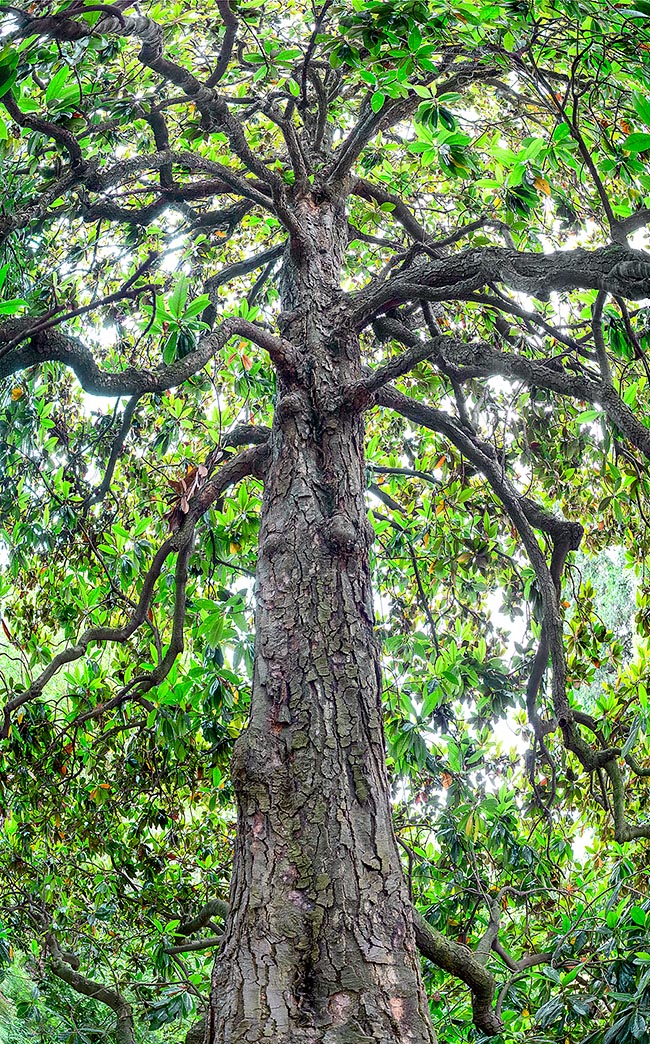
Amply cultivated in parks and gardens, Magnolia grandiflora is native to south eastern USA. Its introduction in Europe dates to early XVIII century with majestic specimens present in historical gardens © Giuseppe Mazza
The genus Magnolia, belonging to the family of the Magnoliaceae includes more than eighty species, arboreal and shrubby, diffused in the boreal hemisphere, mainly in North America, and in the Asian continent, in China, Japan and Korea.
The denomination of the genus is to be ascribed to the dedication of the Swedish scholar Linnaeus to the Director of the Botanical Garden of Montpellier Pierre Magnol who introduced the plant in Europe and operated actively in the scientific field during the second half of the XVII century.
Next to the best-known Magnolia grandiflora L., are amply cultivated also other species of particular ornamental interest because of the elegance of the posture as well as for the decorativeness of the blooming.
We remind, in this regard, among the species more strictly arboreal: the Magnolia obovata Thunb. native to Japan and characterized by big leaves with pleasantly scented white flowers, produced in early summer; Magnolia acuminata (L.) L. with deciduous foliage, coming from North America, with yellow blooms in late spring-early summer; Magnolia campbellii ook.f. & Thomson, also deciduous, and diffused in nature in the mountainous regions of Himalaya, of imposing dimensions as it can exceed the 30 m with eye-catching flowers produced at the beginning of the spring season, before the emission of the leaves of different chromatic gradation of pink between the inside and the outside of the corolla; Magnolia sargentiana Rehder & E.H.Wilson, of size contained more than the previous ones, native to the regions of the Sichuan and of Yunnan, in China, with showy pink blooming of remarkable ornamental value and, finally, Magnolia denudata Desr., diffused in nature in central regions of China, with white flowers intensely scented and bell-shaped, opening before the emission of the leaves, in early spring.
Inside the small-sized Magnolias with shrubby posture we can remind the Magnolia liliiflora Desr. with deciduous leaves, some metres tall with pleasantly scented flowers of white-pinkish colour in the inner part and reddish externally; the Magnolia stellata (Siebold & Zucc.) Maxim. native to eastern Asia, with shrubby posture, deciduous leaves and abundant blooming intensely scented, of white colour and, in some selection, also of pink colour; the Magnolia soulangeana Soul.-Bod. with deciduous leaves, taller than the previous ones as it can even exceed the 5-6 metres of height with abundant and showy bloomings in spring.
The most known and widely cultivated species in parks and gardens is the Magnolia grandiflora, with persistent, native to south-eastern USA, whose introduction in Europe dates back to the early XVIII century.
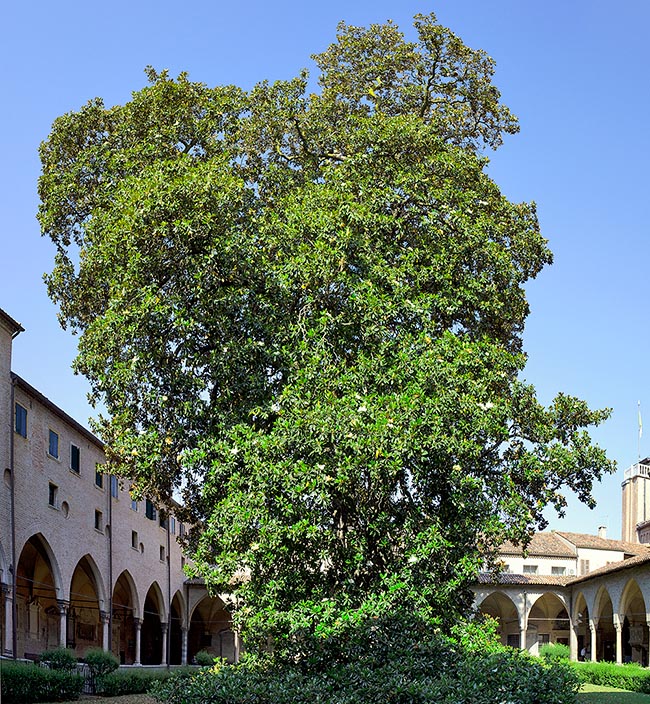
Showy plant, present in the cloister of the Pontifical Basilica of Saint Anthony of Padua (Veneto, Northern Italy) planted in 1810. Surely spanking, though 200 years old, reaches 24 m of height with a 134 cm trunk © G. Mazza
Some particularly aged specimens, even of monumental size, are present in many parks and historical gardens all over Europe and in many botanical gardens among which the one of Pisa.
The specific epithet “grandiflora” refers to the large flowers pleasantly scented that render very eye-catching and decorative the plant for long periods of time.
Dimensionally, it is a majestic tree that, when mature, can exceed even a twenty metres of height, with a very slow growth that commonly means a marked longevity, even of some centuries.
It is presently available at nursery level a selection of dwarf size, known as “Little Gem”, particularly suitable to realize small gardens, in order to avoid during the time the carrying out drastic and mutilating pruning interventions that unluckily can be seen in many green arrangements not correctly planned with this splendid and strong arboreal plant.
From the point of view of external characters connoting the Magnolia grandiflora, we note how the trunk presents a grey-brownish colouration that has reddish hues in the youngest branches.
With time, the rhytidome flakes off in small-sized plaques. The very big leaves, of coriaceous consistency and of an overall elliptic shape reach the length of about thirty centimetres and an intense bright green colouration in the upper pagina and rusty in the lower one connoted by an evident tomentum.
The leaves keep on the plant for about two years. The foliar change occurs almost constantly, even if it is more marked during the warm summer period. This means a constant maintenance engagement in removing the withered leaves fallen on the soil in the case when the plants of magnolia are cultivated along avenues and paths of water bodies and pools.
If the leaves are not taken off, they form on the ground consistent layers of leaves whose decomposition happens slowly, thus rendering difficult the growth of other herbaceous plants, also in relation with the thick shade projected on the soil by the crown of the tree.
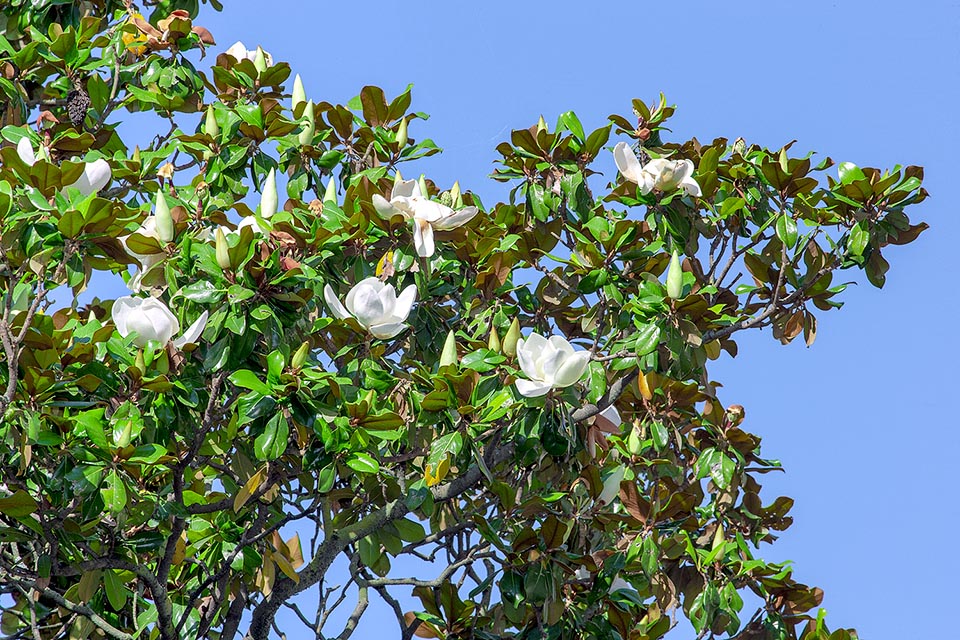
Scented flowers with big white petals, create striking contrast effects to the intense and bright green of the leaves staying on the plant about two years © Giuseppe Mazza
In particular, it is problematic the possibility of realization and maintenance of the lawn under the big magnolias. Projectedly proves very interesting the cultivation of the magnolias as single isolated specimens close to the limits of the lawns so as to render possible the full enjoyment of their majesty and beauty especially in occasion of the bloomings.
The flowers of the M. grandiflora, considered in still primitive evolutionary terms, are solitary, hermaphrodite and with entomogenous pollination. They manifest themselves conspicuously starting from the month of May/June thanks to their huge white petals that create striking contrast effects with the intense and bright green colour of the leaves.
The pleasantness of the blooms is also linked to the intense aroma emitted that recalls the scent of the lemon.
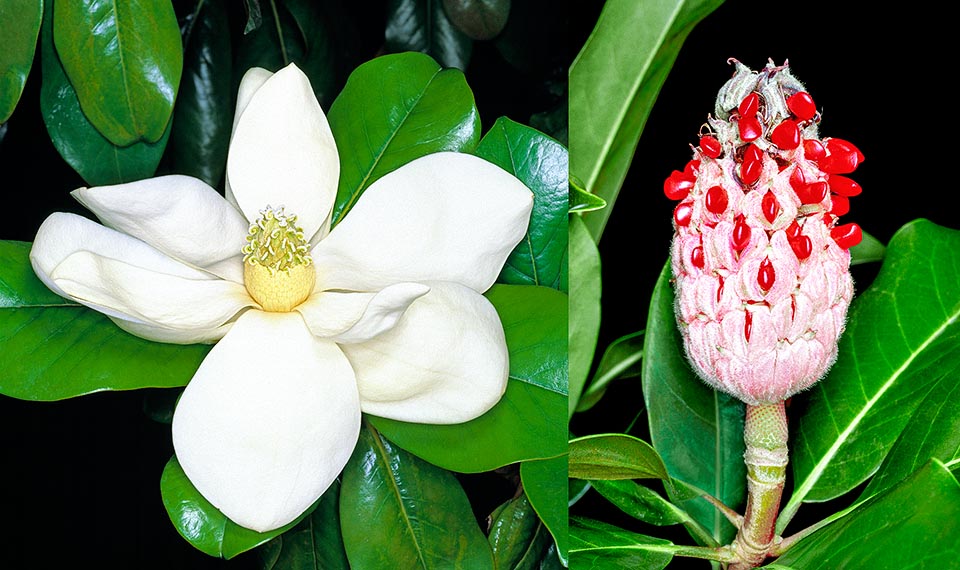
In evolutive terms the flower structure shows primitive characters. The pedunculate infructescences are cone-shaped with red seeds © Giuseppe Mazza
After blooming, takes place the formation of pedunculate infructescence shaped like cones. When ripe the seeds have a lively intense red colouration.
The root system of the Magnolia grandiflora, is robust and well rooted, evidencing a preference for deep, acidic and well drained soils. If the cultivation takes place in calcareous soils with alkaline reaction, the growth gets difficult and stunted with a frequent appearance of extensive leaf yellowings.
Climatically are favourable the cool and rainy sites especially during the summer period, as, for instance, in the Italian prealpine reliefs.
While being able to thrive also in warmer and drier Mediterranean countries, often, the plants meet unfavourable conditions for growing, even for long periods, after planting.
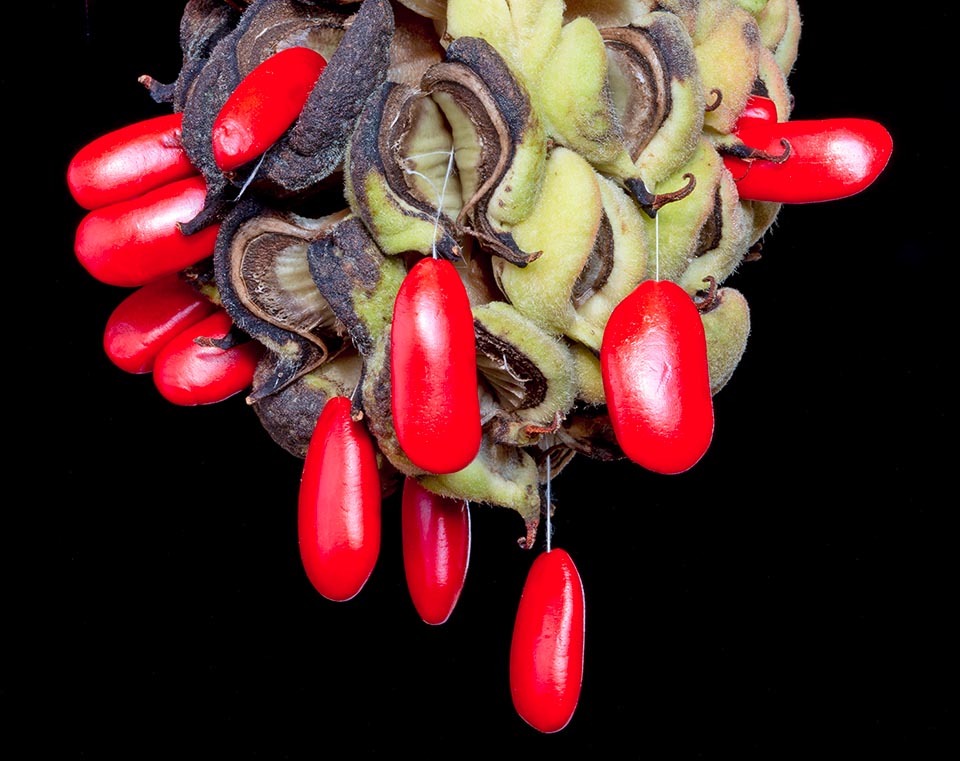
When ripe each fruit opens showing inside 2-6 red or pink loppy seeds, linked to a funicular cord that makes them swing to attract birds attention © Giuseppe Mazza
An interesting aspect emerged from experiences gained during the green design concerns the moderate resistance to pollution in the urban realities of these plants.
The optimal exposition is the full sun or, subordinately, the half-shade. The agronomic management of the plants in the garden foresees the carrying out periodical watering during the first years following the transplant in summer, always avoiding possible water stagnation. The fertilization must be done preferably with organic fertilizer during the first years of the planting. At nursery level, the multiplication takes place by cutting collected during the summer season, or by layering, offshoot, grafting or, at times, also by seed.
In the flower’s language, the magnolia has an interesting link with the virtuous themes of beauty and of firmness of mind.
→ To appreciate the biodiversity within MAGNOLIACEAE family please click here.
